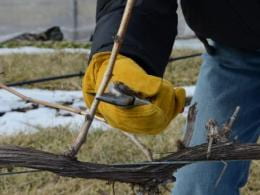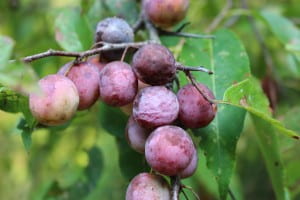Temperatures have dropped into the dumpster for a second time this spring throughout Ohio. Of course, it’s spring and it’s Ohio.
Round one turned beautiful magnolia blooms into brown mush in southwest Ohio. Impacts from this second round are yet to be determined but it’s likely some trees and shrubs suffered frost/freeze damage that will eventually be revealed with symptoms ranging from blasted flowers to wilted, blackened leaves, to twig dieback.
However, feeding damage by the buckeye petiole borer (Zeiraphera claypoleana, family Tortricidae) produces symptoms that are a dead ringer for frost/freeze damage. Wilted leaves on buckeyes (Aesculus spp.) deserve a close look.

Dave Shetlar (OSU Entomology, Professor Emeritus) shared images of the caterpillars in buckeye petioles in central Ohio during our BYGL Zoom Inservice on Tuesday morning. Curtis Young (OSU Extension, Van Wert County) showed images of the symptoms on buckeyes in northwest Ohio and I’m finding damage on wild understory buckeyes in the southwest part of the state.
We’ve noted in past BYGL Alerts that the moth appears to prefer small understory trees growing in wooded areas along streams. I’ve rarely seen damage on mature trees or trees in landscapes. Although the literature notes this native moth is specific to Ohio buckeye (A. glabra), I’ve also observed petiole borer activity on yellow buckeye (A. flava).
Petiole Borer Detection
As their common name indicates, the caterpillars tunnel within leaf petioles to feed on vascular tissues. The damage causes leaves to rapidly droop, wilt, and turn dark green to black. Damaged leaves eventually detach producing mild defoliation.


I’ve never found more than one caterpillar per petiole even where populations are high. Look closely for a slight swelling of the petiole on wilted leaves. There may be a small hole exuding granular-like frass (insect excrement). This indicates there is a caterpillar actively feeding within the petiole.


A clean hole in the petiole indicates the caterpillar has completed its development and exited to pupate in the soil. Slicing open the petiole will reveal a short, empty chamber.


Trees usually only suffer a few damaged leaves. The hit-or-miss nature of the wilted leaves provides good evidence that it’s not frost/freeze injury. Damage by this borer may appear conspicuous; however, the caterpillars seldom cause enough leaf loss to affect the overall health of infested trees.

On the other hand, earlier this week, I found and photographed a caterpillar boring into the tender new terminal growth on a small understory tree in southwest Ohio. I’ve never seen or heard of this type of damage. However, damage to main stems represents a potentially more serious impact compared to the loss of a nominal number of leaves.



There are two generations in Ohio with the first generation coming to an end in the southern part of the state. The vast majority of the petioles I inspected earlier this week were empty with only a few petioles and the aforementioned main stem containing mature caterpillars.
Management
There are no chemical control recommendations given that the damage is usually confined to wild buckeyes growing in wood lots and leaf loss from the petiole borer is seldom significant. However, I’ve seen localized populations gradually increase over successive years to eventually produce very noticeable symptoms with the damage caused by the second generation becoming more severe.

Hand-removal of infested leaves can reduce localized petiole borer populations. The first step is to make certain the petioles actually contain caterpillars; a clean hole means the caterpillar has vacated the premises! Removing first-generation caterpillars will decrease damaged caused by the second generation later this spring and the removal of second-generation caterpillars will help to deplete the overall population.
The second step is to destroy the caterpillar within the infested leaves and stomping is highly effective. Thus far, no populations have become resistant to this control method.
 Join us Saturday, March 18th at the Oasis Conference Center, 902 Loveland-Miamiville Rd, Loveland, OH 45140
Join us Saturday, March 18th at the Oasis Conference Center, 902 Loveland-Miamiville Rd, Loveland, OH 45140

 Come join us for a three-part, online workshop to learn proper pruning techniques to improve production and quality in your apple, grape, and raspberry plantings. You will be online with Ohio State University South Centers experts, who will give live presentations with short pre-recorded videos. They will also answer your questions.
Come join us for a three-part, online workshop to learn proper pruning techniques to improve production and quality in your apple, grape, and raspberry plantings. You will be online with Ohio State University South Centers experts, who will give live presentations with short pre-recorded videos. They will also answer your questions.

















